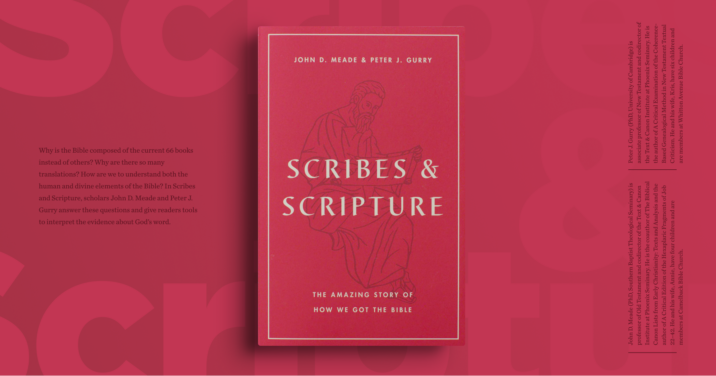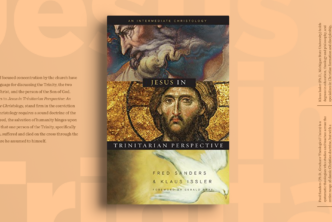Scribes & Scripture: The Amazing Story of How We Got the Bible, is a love letter from the academy to the church, a truly excellent book that will surely become a staple in churches and seminaries all over the English-speaking world.
Authors Peter J. Gurry and John D. Meade have put in the work to become genuine experts on the textual history of the Bible. Gurry did his doctoral dissertation under Peter Head on the coherence-based genealogical method, a cutting-edge methodology for New Testament textual criticism that is every bit as complicated as it sounds. Meade did his under Peter Gentry on the hexaplaric fragments of Job, another area of study that is renowned for its complexity.
The two men have each spent over a decade studying difficult languages, poring over ancient manuscripts, and mastering complicated methodologies. They’ve produced technical journal articles, published academic monographs, and presented papers at specialist conferences.
The upshot: Gurry and Meade genuinely know what they are talking about.
Though they are thoroughly naturalized citizens in the world of the academy, Scribes and Scripture makes it obvious that their pursuit of academic excellence has only increased their love for Christ and his church. They have a clear and genuine affection, both for the Scriptures as the life-giving Word of God and for the non-specialist believers who make up the vast majority of the people of God. This book is what scholarship done in service of the church ought to look like.
Book introduction
Scribes & Scripture is bookended by compelling stories of the love that ordinary believers have for the Scriptures. The introduction opens with the tale of Mary Jones, a poor Welsh girl who saved her money for six years and then walked barefoot for twenty-five miles to obtain a Bible for herself. The conclusion ends with the story of D. J. Ward, an ordinary pastor from a difficult background who faithfully preached the Scriptures in obscurity for forty years.
While Gurry and Meade are happy to celebrate and honor the simple faith of ordinary believers, they are fully aware of the not-so-simple challenges to faith in Scripture that trouble many equally sincere followers of Christ. As they make very clear, you don’t have to be an academic to follow Jesus or master the technical details of textual criticism to feast on the Word of God. At the same time, the fact remains that we live in a world in which professional skeptics routinely use the ignorance of ordinary believers to undermine their confidence in the Scriptures, at times causing them to abandon the faith altogether. This sort of tragedy, Gurry and Meade insist, is entirely unnecessary.
Faith ought not lead us to cling to our ignorance like a paper shield. It ought instead to motivate us to be foremost in the quest for understanding the world God has given us. Those who truly believe that the Scriptures are the words of God, providentially kept for us by God, do not need to be afraid of learning the amazing story of how he chose to do that, even when that story is a bit messier than we might have liked. This book tells that story, and tells it well.
As Gurry and Meade organize it in their book, the story begins with text, the work of copying the manuscripts of the Old and New Testaments. It continues with canon, the work of gathering of the Scriptures into bounded collections. It finishes with translation, the work of making the Scriptures available to ordinary believers in their own mother tongue. Gurry and Meade devote three chapters to each of these sections.
Text
For those who grew up in our late-modern screen-saturated society, it can be difficult to imagine a world in which hand copying was the only form of “textual transmission”—the only way any text could be transmitted from one place (or one generation) to another. Gurry and Meade therefore begin at the beginning, carefully explaining what we know about the origin of writing, the materials on which ancient manuscripts were copied, and the culture of scribes.
Having oriented their readers to the overall concept of textual transmission, they turn to a more detailed look at the textual transmission of the Old and New Testaments, devoting a chapter to each. With a plethora of useful charts and helpful images, they walk us through the necessity of textual criticism, overview the primary “witnesses” to the texts of each testament (that is, the most important manuscripts), explain what we know about scribal copying practices, and give practical examples of the way scholars evaluate all of this evidence as they strive to discover the original text of Scripture.
Perhaps unsurprisingly, the chapter on the copying of the Old Testament will likely prove the most challenging for the non-specialist reader. Though it is written as clearly as possible, and though it does not assume any prior knowledge of the subject, there does come a point at which things can’t be made any simpler without becoming a bit reductionistic.
In order to give pastors, college students, and educated laypeople the answers they need to respond to the questions they face, it is necessary to dive a bit more deeply than many congregants will be able or willing to swim. Because of this, as clear and compact as this book already is, there would still be a significant benefit in producing an abridged and simplified version of this material that would outline the essential basics of the story of Scripture in a way that would be accessible to even those members of Christ’s flock who could feel a bit overwhelmed by the level of detail that Gurry and Meade provide in Scribes & Scripture.
At the same time, there is one point where, given what seems to be the primary intended audience, more detail would have been helpful. Gurry and Meade rightly emphasize that the relationship between the various early Greek translations of the Old Testament (often, though somewhat imprecisely, referred to as “the Septuagint” or “the LXX”) and the Masoretic Hebrew Text (MT) can be somewhat messy. They even note that some variants in Ezekiel may reflect different “editions” of the work and point out that “perhaps the literary shape of some chapters in 1 Esdras and LXX-Nehemiah 11 is earlier than the parallel chapters in Ezra-Nehemiah and Chronicles in the MT.”1 Yet, in classifying these examples as “instances of free copying or translating,”2 they don’t seem to me to adequately wrestle with the difficulties posed by the examples they provide. While it is fully understandable that resolving such thorny interpretive thickets falls outside the scope of a book like this, it could have been helpful to include a footnote recognizing that some of these examples are much harder to resolve (and much more contested) than the example they give from the additions to Esther.
Considering we know quite a bit more about the copying of the New Testament than we do about the copying of the Old Testament, the chapter dealing with the textual transmission of the New Testament is somewhat easier going. It outlines the three categories of documents used for establishing the original text of Scripture: Greek manuscripts of the New Testament, ancient translations (“versions”), and citations (such as those made by church fathers). Then Gurry and Meade give some practical examples of how scholars weigh this evidence in practice.3
Canon
Having carefully surveyed what we know about the way the text of Scripture was written and copied, Gurry and Meade turn to consider how we know which books belong in Scripture to begin with. The first chapter tells the story of the Old Testament canon up to the Reformation; the second chapter works through the Reformation-era debate on the status of the books Protestants now classified as “Apocrypha,” and the third chapter tells the story of the New Testament canon.
On the one hand, Gurry and Meade handily refute the sensationalistic claims made, for example, in Dan Brown’s bestselling novel The Da Vinci Code. There isn’t a shred of evidence to support the (now widespread) belief that the boundaries of Scripture were arbitrarily picked by a pagan Roman emperor or a group of power-hungry male bishops who were desperate to suppress the voices of women. The central core of the canon of both the Old and New Testaments was never subject to any significant doubt or widespread debate. Books like the Pentateuch of Moses and the prophecy of Isaiah, the four Gospels, and the letters of Paul have always been recognized as Scripture. The popular idea that no one knew what Scripture was until the church settled on a canon in the fourth century is without any foundation whatsoever.
On the other hand, Gurry and Meade don’t shy away from the messiness that we find around the edges of the canon. Many early Christians accepted some of the books Protestants would now consider to be apocryphal—like Sirach or the additions to Daniel. Other early Christians had doubts about books like Revelation or 3 John. Yet as their careful historical work demonstrates, the story of the canon is not fundamentally a story about untrustworthy decisions by unsavory characters, but a story about the steady providence of God working through ordinary humans to slowly bring the boundaries of Scripture into focus.
Translation
The third and final section of the book deals with the story of translation. For those already thoroughly familiar with the details of textual criticism and canon, this may well prove to be the most helpful section of the book. Rather than starting with modern translations, Gurry and Meade take us back to the beginning, opening this section with a historical overview of Bible translation in the early church and the Middle Ages.
As the authors ably demonstrate, the difficulties posed by the existence of a plurality of differing translations are by no means a merely modern phenomenon. From the very beginning, God’s people have had to wrestle with the realities that translation always involves interpretation, that language change means the task of translation is always ongoing, and that even the most skilled and well-intentioned translators sometimes make mistakes.
They also correct the mistaken notion that the Middle Ages were a time in which ordinary Christians were entirely cut off from access to the Scriptures. Though some localized opposition to vernacular translations did exist, especially in England, there never was a universal ban on the translation of the Bible into the language of the people. Though the widespread ignorance of Greek and Hebrew in Western Europe meant that translations were normally made from the Latin, the work of many unknown and unsung translators and scribes meant that ordinary believers never fully ceased to read the Scriptures for themselves.
With this foundation laid, Gurry and Meade focus the last two chapters of the book on the story of English Bible translation, from the first halting and partial translations into Anglo-Saxon to the abundant flowering of excellent translations available at the beginning of the twenty-first century. Though some Christians today feel threatened by the availability of multiple translations, Gurry and Meade demonstrate that, throughout the history of the church, this has been the norm rather than the exception.
English Christians living in the period between the pioneering work of Tyndale and the production of the King James in 1611 had access to a wide variety of translations. Furthermore, wonderful as the work of the King James translators was, its eventual unilateral dominance was not due solely to its intrinsic merit but also to the active and at times very heavy-handed intervention of the English crown.
The final chapter gives a brief introduction to the story of English translations from the Revised Version of 1881 to the present. This section offers a clear guide to the many reasons why translations differ. Translation from one language to another always involves tensions and trade-offs. In deciding how to deal with idioms and word-play, translators make decisions based on their chosen theory of translation. Further challenges come from changes in the English language, new discoveries by textual critics, and more.
As Gurry and Meade conclude, rather than immediately calling the motives of translators into question when they make a decision that we as readers don’t like, we should instead be deeply thankful for the always difficult and often thankless work that translators do on our behalf. Instead of obsessing about what determining which translation is best, we should be grateful for the benefits that come with the ready availability of multiple good translations.
Book conclusion
Having finished their threefold survey of text, canon, and translation, Gurry and Meade circle back to the fundamental theological question they raised in the introduction. What are we, as the followers of Jesus, to make of the story of Scripture? Should we, as so many skeptics allege, feel threatened by the sometimes messy details? Should we feel flattened by the questions we can’t yet answer and the difficulties we have not yet been able to resolve?
Not at all, Gurry and Meade insist. On the one hand, it is unwarranted to conclude, as some do, that we shouldn’t trust the Scriptures simply because they are some questions we can’t answer. On the other hand, it is unhelpful to attempt, as some do, to bury our heads in the sand and ignore the difficulties altogether.
Instead, we should trust in the providence of God. Rather than going to God and telling him what level of messiness we are comfortable with, we should recognize his authority to do things the way he sees fit. Yes, we should always strive for understanding. We should, as God gives us ability and opportunity, seek to answer as many questions as we possibly can. We should be amazed and astonished by the story of how the Scriptures have come down to us.
But at the end of the day, our fundamental attitude toward the Scriptures must be faith, our fundamental affection must be love, and our fundamental action must be obedience. Just as ordinary believers need the the careful historical work of scholars, so also do scholars need the everyday transformative faith of ordinary believers like Mary Jones and D. J. Ward.
Review conclusion
As a final minor critique, the bibliographies at the end of each chapter would have greatly benefited from some light annotations indicating their relative availability and difficulty level. Some of the books recommended, like the Brill-published Textual History of the Bible, are extremely expensive specialist publications that many readers will find very difficult to access, even in a library. Others are obvious and affordable next steps. If there is a second edition of this book, it would be helpful to add some comments distinguishing between the two kinds of resources.
In conclusion, Scribes & Scripture is an obvious labor of love. While its broad scope ensures that it will prove an informative read even for specialist scholars, its clear language and simple explanations will make it especially valuable for pastors, church leaders and anyone interested in or wrestling with questions about how the Scriptures have come down to us. May the tribe of such love letters as this increase abundantly. May it succeed in the purposes for which it was written. May its reading strengthen your faith in the Scriptures, deepen your love for the Scriptures, and quicken your obedience to the Scriptures.
- John D. Meade and Peter J. Gurry, Scribes and Scripture: The Amazing Story of How We Got the Bible (Wheaton: Crossway, 2022), 75.
- Ibid., 74.
- As a minor quibble, when it comes to patristic citations, Gurry and Meade present the most common view, in which such citations, at least when taken from properly edited editions, can help us to geographically and chronologically pinpoint readings found in continuous-text Greek manuscripts of the New Testament. Based on my study on textual variation in the manuscript tradition of Chrysostom’s Homilies on Romans, this view obscures the constant mutual influence that took place between manuscripts of patristic works and manuscripts of the New Testament. Rather than seeing the sermons and commentaries from which most such citations are taken as a “third strand” of evidence (Ibid., 90.) it would perhaps be more precise to see them as a sub-current of a single broader river of textual evidence, constantly subject to the influence of the broader stream—and at times also being a source of influence on it.







